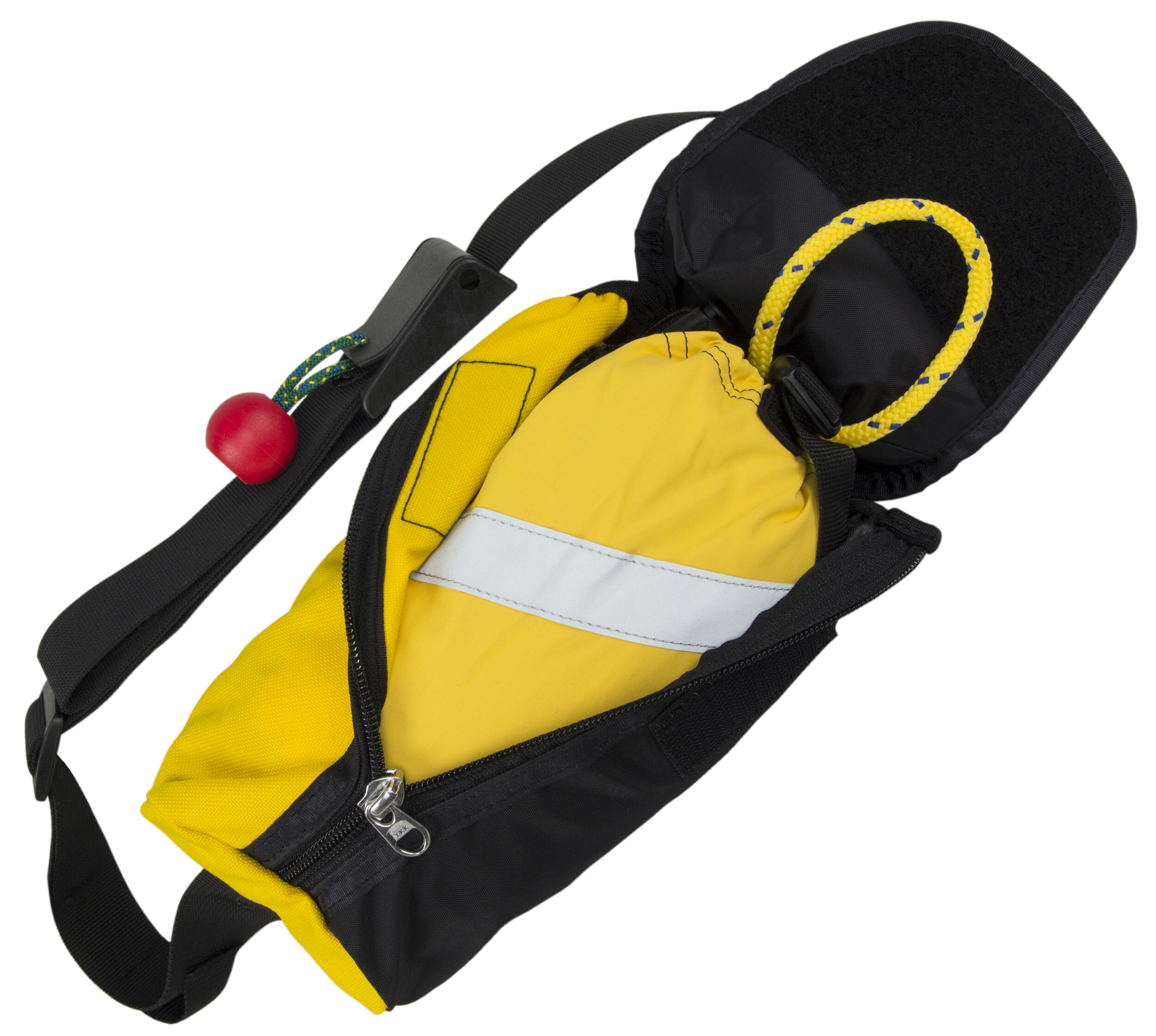The Gear Shed - NRS Pro Guardian Waist Bag
Rope Material: Polypropylene sheath with Spectra core
Rope Length: 55’
Rope Diameter: 1/4 inch Sterling Ultra Line
Max Load Rating: 2495 lbs (11.1 kN)
MSRP: $99.95
NRS Pro Guardian Waist Bag Review
Of all the bags on the market this is actually my go to bag. I like the bag in a bag design since it mitigates the risk of snags and helps adhere more closely to the clean principal. I love the slim profile and wedge design. I used to use an older version of this bag without the wedge design and this updated version makes it much easier to repack your bag. I usually attach several Molle Flash Grenade Pouches to the belt so I can store my rescue hardware. There are several features and design elements I am not a huge fan of on this bag, but in general this is a really impressive overall design concept. My biggest problem with the bag is the 1/4” rope that is used. Bumping the rope diameter up would make this bag more heavy and bulky for the same length of rope, but that’s the trade off for having a compact bag always close at hand.
Ideal Uses
This bag really shines on funky portages, adverse rescue situations, ultra-light or minimalist river trips, and places where you are required to climb or have your hands free to get to along the river. This is also great if you need quick access to your rope when you are walking along the river. Situations involving 1 or 2 swimmers on the line or light R2 play boat recovery or light duty rescue in really the name of the game with this bag.
How is it in the water?
Swimming with this bag is great, it sits just below your PFD and out of the way. The slim profile doesn’t create too much drag in the water. As with all waist bags it does provide a small measure of flotation and lower back protection. I have had several times the bag absorbed an impact during a swim I otherwise would have taken to my spine. I have also used mine to rescue swimmers after I swam to shore or an eddy and friends swam out of the same boat but could not make it to safety. The bag is really good for rapid deployment or swimming out to a wrapped boat. It is great to have it right there at your fingertips.
How tough is it?
After having several of these over the years I have found that the rope quality is pretty solid. It can take multiple stretches under serious (wrapped boat level) tension before it gets stretched out (this is not a recommended use of dynamic rope by the way, but it can work in a pinch). I have ground this thing in the dirt, abraded it against rocks, used it for mechanical advantages, and left it wet in a gear bag for way too long. I have cut open my old ropes in the past just to see how bad the core is, and they have held up remarkably well. It will gladly take any abuse you want to throw it’s way.
The bag itself is ok and reasonably strong, but it is not load bearing. I have seen bag rips from improper loading or scared people clawing at the fabric. NRS did a good job of adding fabric to help drain the bag and reinforce the actual bag against damage, but it ultimately pretty thin.
The belt is great material and is as tough as you would expect seatbelt webbing to be. I have slid the outer bag cover over multiple rocks and abrasive surfaces without damage. It does add an extra layer of protection knowing that your bag is tucked away.
The zipper is decent and hasn’t rusted or corroded on any bag I have owned over the years.
The hook and loop closure is an issue. I have had the threads rip out on the hook and loop patches on several bags and have had to resew the patches back on.
Important Considerations
The biggest drawback to the bag is the rope diameter. At ¼” it can really burn holes in your hands if you are not careful. It is also difficult to hold on to with 2 or more large people on the line. The amount of weight spread over such a small area really becomes painful quickly.
The rope is dynamic so it makes for a sub-par line to free a wrapped boat with. You really want static line for that purpose, but it will work if it is your only option.
The carabiner loops often get caught in the quick release if you don’t properly position the waist belt. You may want to consider cutting or unstitching the carbineer loops on the tail side of the belt.
The loop in the bag comes pre-knotted; if it is too big or you can fit a hand in there you may want to re tie the end into the bag to bring it more in line with the clean principal.
The carabiner loops can be a hazard if you actually use it for carabiners since it adds an additional entrapment point. We recommend getting some pouches to hold any extra rescue gear.
Throw bags require special training and skills to use. Lines in the water can be a hazard and without special training having 55 feet of rope attached to your back can be a serious hazard. Don’t just carry one to carry it, learn how to use the system and all of the included safety features.
If your rope is damaged, abraded, moldy, full of dirt, sun-bleached, or otherwise seems compromised, it is important to replace your bag as quickly as possible. Nothing would feel worse than nailing a rescue with the bag before someone drops into a rapid just to have your rope snap and the person is now swimming with a rope in the water. Inspect your rope daily after each trip by emptying the bag and letting it dry.
The bag in a bag design does add a lot of abrasion resistance to the bag as well as keeping it in pace on your waist. This design also eliminates the tossing the whole belt method of some comparable bags so it is a little nicer for the victims you are rescuing.
Is it worth the cost?
This bag is definitely a solid value for a do all rope at a good price point. The question of value though comes from your preference of rope. If you don’t mind the ¼” rope and only pan to use it for R2ing light boats or light commercial rescue work this is a really solid option. If you are not a fan of ¼” rope then you will likely want to look elsewhere for rope.
If you are on wider big water rivers this may not be the ideal option since boat bags will offer a much better option with larger diameter rope. One of the hidden costs of a throw bag, especially a waist bag is the training. It’s important to not be just throwing rope at every swimmer and understand how and why you are getting a throw bag.







